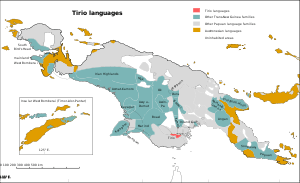Tirio languages
The Tirio languages are a family of Trans–New Guinea languages in the classification of Malcolm Ross. The Tirio languages have about 40% of their lexicon in common.
| Tirio | |
|---|---|
| Lower Fly River | |
| Geographic distribution | New Guinea |
| Linguistic classification | Trans–New Guinea |
| Glottolog | tiri1259[2] |
 Map: The Tirio languages of New Guinea
The Tirio languages
Other Trans–New Guinea languages
Other Papuan languages
Austronesian languages
Uninhabited | |
Languages
Evans (2018) lists the Tirio languages as:[3]
- Tirio (Makayam)
- Bitur (Paswam, Mutum)
- Lewada-Dewara, spoken on Dewala village on Sumogi Island
- Adulu (Aturu), also spoken on Sumogi Island
Baramu is somewhat more divergent in vocabulary, but this may reflect language contact rather than divergence in its position within the family. Pronouns are only available for Tirio itself (Makayam).
The moribund language Abom was once classified as a divergent Tirio language, sharing only an eighth of its lexicon with the others, but it turns out to not belong to the family at all, nor to the Anim family that Tirio is a branch of.[4]
Phonemes
Usher (2020) reconstructs the consonant inventory as follows:[5]
*m *n *p *t *k *mb *nd *ŋg *s *w *ɾ *j *ɣ
Vowels are *a *e *i *o *u.
Evolution
Lower Fly River (Makayam and Baramu) reflexes of proto-Trans-New Guinea (pTNG) etyma:[6]
- Makayam makoːth, Baramu mangoːt ‘chin’ < *maŋgat[a] ‘mouth, teeth’
- Makayam (Giribam dialect) Bitur, Baramu moːm ‘seed’ < *maŋgV ‘fruit, seed, round’
- Makayam sakoa ‘lower arm’, Baramu saga ‘arm’ < *sa(ŋg,k)(a,i)l ‘hand, claw’
References
- New Guinea World, Fly River
- Hammarström, Harald; Forkel, Robert; Haspelmath, Martin, eds. (2017). "Tirio". Glottolog 3.0. Jena, Germany: Max Planck Institute for the Science of Human History.
- Evans, Nicholas (2018). "The languages of Southern New Guinea". In Palmer, Bill (ed.). The Languages and Linguistics of the New Guinea Area: A Comprehensive Guide. The World of Linguistics. 4. Berlin: De Gruyter Mouton. pp. 641–774. ISBN 978-3-11-028642-7.
- https://sites.google.com/site/newguineaworld/families/trans-new-guinea/fly-river/lower-fly-river
- New Guinea World, Lower Fly River
- Pawley, Andrew; Hammarström, Harald (2018). "The Trans New Guinea family". In Palmer, Bill (ed.). The Languages and Linguistics of the New Guinea Area: A Comprehensive Guide. The World of Linguistics. 4. Berlin: De Gruyter Mouton. pp. 21–196. ISBN 978-3-11-028642-7.
- Ross, Malcolm (2005). "Pronouns as a preliminary diagnostic for grouping Papuan languages". In Andrew Pawley; Robert Attenborough; Robin Hide; Jack Golson (eds.). Papuan pasts: cultural, linguistic and biological histories of Papuan-speaking peoples. Canberra: Pacific Linguistics. pp. 15–66. ISBN 0858835622. OCLC 67292782.
External links
- Timothy Usher, New Guinea World, Proto–Lower Fly River